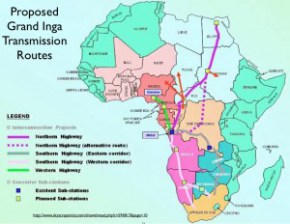Grand Inga Dam: Africa’s Path to Electrification?Feb 7, 2013 - By Joelmallory - Wordpress.com Twenty-five miles from the mouth of the Congo River, the Inga Falls potentially holds the future of Africa’s power generation. The largest waterfall in the world by volume, Inga Falls will potentially be the future site of a hydroelectric power plant with over 40,000 megawatts (MW) of capacity. This will be the largest facility of its kind in the world, more than doubling China’s Three Gorges Dam. Currently the falls support two dams, Inga I and Inga II, with a capacity of 351 MW and 1,424 MW respectively; however they are only operating at 40% capacity due to improper maintenance. [1] The project will take place in three stages as funding becomes available. The first stage will be a rehabilitation of Inga I and Inga II to remove a blockage at the intake canal and perform additional maintenance. The next phase will be to build Inga III, which could generate between 4,300-5,000 MW at a cost of $8 billion. [2] The final phase would be to build Inga IV, also known as Grand Inga at an estimated cost of $80 billion. At the completion of the project the power supplied could electrify up to 500 million Africans currently without power.
http://www.maximizingprogress.org/2011/07/grand-inga-african-congo-hydro.html Rehabilitation of Inga I & II Built in 1972 and 1982, Inga I and II have long been considered “white elephants” for the Democratic Republic of Congo (DRC). They make up a significant portion of the country’s debt load and have underperformed for years due to improper maintenance. There have also been lasting social impacts including not living up to its obligations to compensate those forced to relocate due to the dam’s construction. [1] The fiscal and social drawbacks notwithstanding, the World Bank is leading a proposal to rehabilitate the current facilities at an estimated cost of $500 million. This program was expected to restore capacity to the current operations as well as construct additional transmission lines to the nearby urban center in Kinshasa. This is an effort to add an additional 50,000 connections to the grid although these connections are not specified as being for commercial or residential use. It was also discovered through recent efforts that large boulders have moved and partially blocked the intake canal for these two dams. Even after the $500 million in planned renovations it is likely that only 70% of capacity will be reached. Removing the boulders would only be possible by draining the reservoir, leaving the few electrified cities in the DMC without power. [1] Proposed Inga III & Grand Inga The proposed expansions at Inga Falls would add upwards of 44,000 MW of capacity to the region. With mineral rich deposits nearby, several foreign investors have looked to help partner with the DRC. In exchange for companies building energy intensive smelting operations, DRC would guarantee electric capacity from the expanded dams. As recently as 2007 BHP Billiton had an agreement with DRC to supply 2,500 MW to a proposed facility. This agreement strained relations between other African nations that had planned to help develop the dams in exchange for energy considerations. After the dissolution of the agreement with BHP, the other African nations once again signed on to the proposed development of Inga III and Grand Inga projects. The proposal promises to electrify Africa by bringing electricity to 500 million Africans. However, there is significant concern over the political climate and whether the power generated will be used for the poor masses. International Rivers believes the political turmoil in the region will lead to a mired process of bribes and kickbacks. There are also concerns about who will receive the power. As part of the financing agreements and initial plans, cross-continent transmission lines are proposed removing the resources from the people most affected by its construction. For the DRC to benefit from the project directly, local AC transmission lines would need to be built – a provision not built into current proposals. [3]
While there is great promise in harnessing one of the largest potential sources of hydro-energy, the direction the project is currently headed will not electrify Africa as promised. Foreign industrial companies would be the largest beneficiaries as well as the more developed economies of Egypt and South Africa. Without provisions to build out and develop localized power transmission lines, this project will continue to saddle the Democratic Republic of Congo with the debt of a project that will not allow the region to see the social gains associated with such a vast resource. The World Bank will play a pivotal role in ensuring the project will be for the betterment of the African people, not the exploitation of their resources. [1] http://www.internationalrivers.org/resources/inga-1-and-inga-2-dams-3616 [2] http://www.theafricareport.com/central-africa/grand-inga-the-ultimate-african-power-project.html [3] http://www.internationalrivers.org/resources/congo%E2%80%99s-energy-divide-factsheet-text-3413
|
Email this page to a friend
If you speak another language fluently and you liked this page, make
a contribution by translating
it! For additional translations check out FreeTranslation.com
(Voor vertaling van Engels tot Nederlands)
(For oversettelse fra Engelsk til Norsk)
(Для дополнительных
переводов проверяют
FreeTranslation.com )


